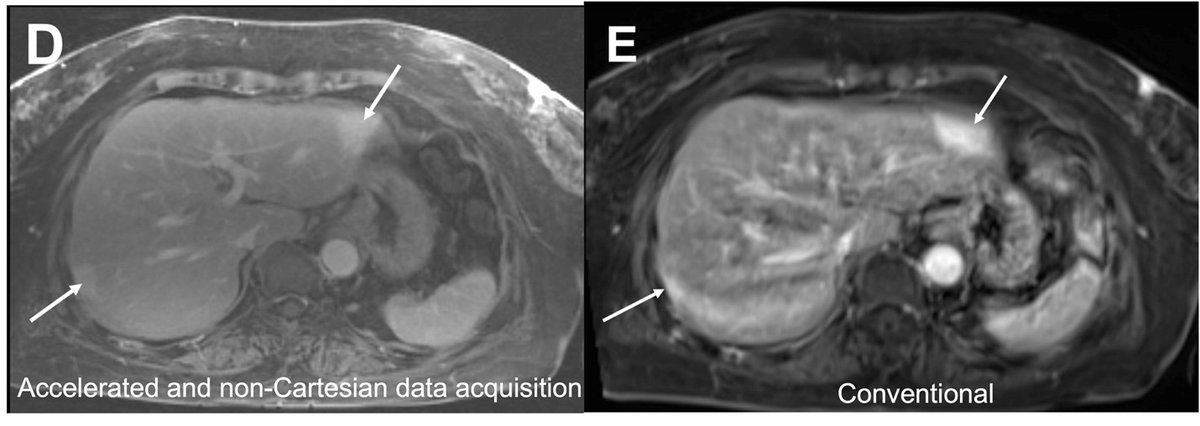Ever wondered how could we improve motion artifacts on abdominal MRI?
A #TWEETORIAL based on our RESEARCH IN PRACTICE article for #RadIntraining @radiology_rsna
@MGHImaging @nyulangone @IcahnMountSinai @BarunBagga
A #TWEETORIAL based on our RESEARCH IN PRACTICE article for #RadIntraining @radiology_rsna
@MGHImaging @nyulangone @IcahnMountSinai @BarunBagga

2/ 17
This focused review article by our team discusses methods that can be applied to manage respiratory motion in abdominal MRI.
Link: pubs.rsna.org/doi/epdf/10.11…
This focused review article by our team discusses methods that can be applied to manage respiratory motion in abdominal MRI.
Link: pubs.rsna.org/doi/epdf/10.11…
3/17
Take away:
Newer strategies to manage respiratory motion include accelerated imaging or free-breathing motion-robust image acquisition.
Artificial intelligence methods to manage motion artifacts are under development but require testing for generalizability
Take away:
Newer strategies to manage respiratory motion include accelerated imaging or free-breathing motion-robust image acquisition.
Artificial intelligence methods to manage motion artifacts are under development but require testing for generalizability
4/17
Techniques to manage respiratory motion can significantly improve image quality. For example, liver imaged during free breathing with and without motion suppression:
Techniques to manage respiratory motion can significantly improve image quality. For example, liver imaged during free breathing with and without motion suppression:

5/17
What do you think is a normal breath hold duration for a normal person?
What do you think is a normal breath hold duration for a normal person?
6/17
Typical breath hold duration is 10–20 seconds.
Typical breath hold duration is 10–20 seconds.
7/17
Because of its short repetition time and small flip angle, gradient echo (GRE) imaging is fast and 3D T1- weighted GRE image can be obtained in a single breath hold.
Whereas a 2D- T2-weighted imaging of the whole abdomen using the turbo spin-echo sequence takes minutes.
Because of its short repetition time and small flip angle, gradient echo (GRE) imaging is fast and 3D T1- weighted GRE image can be obtained in a single breath hold.
Whereas a 2D- T2-weighted imaging of the whole abdomen using the turbo spin-echo sequence takes minutes.
8/17
Respiratory motion in general can be managed by:
a) free-breathing image acquisition with respiratory triggering or gating or,
b) accelerated imaging that can shorten the time of image acquisition and thus a decrease in the breath-hold duration,
Respiratory motion in general can be managed by:
a) free-breathing image acquisition with respiratory triggering or gating or,
b) accelerated imaging that can shorten the time of image acquisition and thus a decrease in the breath-hold duration,
9/17
With respiratory triggering or gating techniques, patients can breathe normally, and data can be either collected at the same phase during the respiratory cycle (triggering) or acquired continuously and then selected retrospectively (gating).
With respiratory triggering or gating techniques, patients can breathe normally, and data can be either collected at the same phase during the respiratory cycle (triggering) or acquired continuously and then selected retrospectively (gating).
10/17
Navigator techniques can prospectively coordinate specific stages of the respiratory cycle and data is collected by tracking the lung-liver interface with a radiofrequency pulse.
Navigator techniques can prospectively coordinate specific stages of the respiratory cycle and data is collected by tracking the lung-liver interface with a radiofrequency pulse.
11/17
Accelerated or fast MRI techniques include parallel imaging and/ or compressed sensing can provide acceleration of MRI data acquisition
Accelerated or fast MRI techniques include parallel imaging and/ or compressed sensing can provide acceleration of MRI data acquisition
12/17
But fast- imaging does not mean motion-robust MRI acquisition. Motion robust acquisition techniques include:
But fast- imaging does not mean motion-robust MRI acquisition. Motion robust acquisition techniques include:

13/17
Non-Cartesian imaging can be performed during free breathing with repeated central k-space sampling, such as radial imaging.
Non-Cartesian imaging can be performed during free breathing with repeated central k-space sampling, such as radial imaging.
14/17
Artificial intelligence (AI)-based methods to improve image quality include AI-enabled fast imaging, or AI-enabled artifact reduction techniques.
Artificial intelligence (AI)-based methods to improve image quality include AI-enabled fast imaging, or AI-enabled artifact reduction techniques.
15/17
Example of AI-based deep learning (DL) technique utilized for motion-suppression from the article:
Example of AI-based deep learning (DL) technique utilized for motion-suppression from the article:

16/17
But the current challenges for various AI techniques is their generalizability. There is also a growing body
of literature documenting the artifacts introduced by DL methods and reconstruction instabilities.
But the current challenges for various AI techniques is their generalizability. There is also a growing body
of literature documenting the artifacts introduced by DL methods and reconstruction instabilities.
In summary, various methods for accelerated imaging, as well as free-breathing techniques can be synergistically combined for improved management of respiratory motion.
pubs.rsna.org/doi/epdf/10.11…
pubs.rsna.org/doi/epdf/10.11…
• • •
Missing some Tweet in this thread? You can try to
force a refresh





